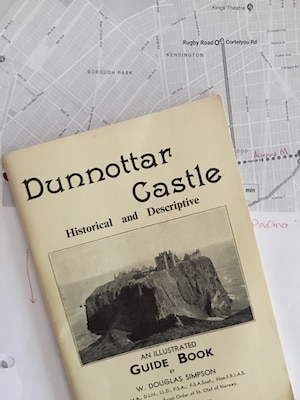
The world you create for your readers has to be a place they can picture in their minds. It has to be believable, even if it’s a fantasy world. It’s like a base camp; your reader needs to be able to settle there and feel comfortable as they acquaint themselves with the characters you create and the adventures you send them on.
My novel-in-progress is set in two time periods — present-day New York City and 14th century Scotland. I have been to NYC and Scotland, but not to the neighborhood my characters live in. I have not had the pleasure of visiting the ruins of Dunnottar Castle where that part of the story takes place. So what could I do to make these places real and believable in my story?
New York City
First, I had to figure out what part of the city my characters would live in, based on their income and other factors. My son-in-law (who lived in NYC for a time) helped me establish the general, logical area. From there, I spent a lot of time researching and looking at Google Maps to determine the street where they would live, the train Jenna would take into the city, and the nearest hospital she would rush to when tragedy struck. I created a couple of businesses, and the apartment where Jenna lives is next to an awesome, Czech bakery. I checked the maps to ensure that there were other, similar businesses in the area, and I created my own business to avoid any legal issues with using an existing business. I also created the travel agency where Jenna worked in the city; the neighborhood is appropriate, but the business only exists in the story. Now that I had New York City pretty much set, I headed (mentally) across the pond to Scotland.
14th Century Scotland
I have traveled to Scotland on more than one occasion, but I have never visited Dunnottar Castle, where the other part of the novel is set. As much as I would love to hop on a plane and explore the castle ruins, my budget and the pandemic are significant barriers right now. And, I need to keep writing! Back to the Internet I went, researching and printing out pages of family history, notable events, and timelines. Some pages contradicted others. History that far back can be vague and unreliable, but I gathered up what information I could find that seemed to support each other. I found a book online that has floor plans and great tidbits of information that the online postings do not.
I feel well-prepared to create the worlds where my characters will live and where their adventures will unfold. I have a good, firm foundation that readers will feel good about settling into. They know nothing of the hours of preparation and research I’ve spent making it comfortable and believable for them, but it will pay off in the end when they immerse themselves in my story. And, you can be sure that Dunnottar Castle is on my list of places to visit on my next trip to Scotland!

Mandy Fernandez
Doing your homework is key. Are you going to include footnotes or references in your book related to your setting research? I recently read a book called “Fever 1793” by by Laurie Halse Anderson. Her book is historical fiction about a young girl’s experience with yellow fever in Philadelphia. The author had done a lot of research, not just on setting but about life during that time period. At the beginning of each chapter, she included an excerpt from a book/essay/literature piece that she had studied/read that helped her write the book. It was very intriguing and helped give the story more credibility. Just a thought. Thanks for sharing your thoughts.
Lauren
I like to read historical fiction, I would find footnotes, references, and such excerpts very distracting. I don’t think I’ve ever seen this done. Such references would take me right out of the story, and I’m reading to get lost in it (in a good way). Remember, it’s a novel, not an academic tract. If the author feels the need to provide references, etc., I’d recommend putting them in the back of the book.
DT
I would love to know about the 14th century Scotland. I may not prefer footnootes in historical fiction, but I would appreciate the references and/or detailed information in something such as appendices at the end of the book.
Best wishes
Niki Kantzios
It sounds fascinating. I love Scotland, and look forward to reading your book when it comes out.